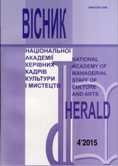ОСОБЛИВОСТІ ІКОНОГРАФІЇ ЗОБРАЖЕНЬ НА ІКОНАХ З УСПЕНСЬКОГО СОБОРУ КИЄВО-ПЕЧЕРСЬКОЇ СВЯТО-УСПЕНСЬКОЇ ЛАВРИ
Iconography’s features of images on icons from Uspensky Cathedral of Saint-Uspensk Kiev-Pechersk Lavra
Author(s): Olga Olegivna RyzhovaSubject(s): Christian Theology and Religion, Architecture, Visual Arts, Semiology, Cultural Anthropology / Ethnology
Published by: Національна академія керівних кадрів культури і мистецтв
Keywords: icons from Uspensk cathedral; attribution; iconography; Kiev-Pechersk Lavra;
Summary/Abstract: The article presents the art criticism analysis of icons from Uspensk cathedral, which are stored in the collections of the National Kyiv-Pechersk Historical and Cultural Reserve.As a result of technical and technological research and iconographic studies of monuments, the attribution was verified and iconography’s features were identified.Consideration of some icons from the museum collections NKPIKZ provides additional material for various comparisons, iconographic analysis; extends and supplements knowledge about XVIII century Lavra icon. Made on request of clerics in workshops of Kiev-Pechersk Lavra, these works significantly expand the idea of time, artists, artistic techniques and tastes of customers.Now, there are enough possibilities for a more thorough and detailed review of Lavra icon painting works of the XVIII century: works of 1970-2000 years, published by national researchers on individual monuments, icons uncovered from under latest layers. There we got a need to summarize the available material and complement it with works that have not yet entered into scientific circulation, or those that have not got yet exhaustive interpretation.The relevance of this publication is to identify the features of interpretation of iconic image in the XVIII century Lavra icon painting.The purpose of the article is to introduce the icons from the Assumption Cathedral, which are stored in the collections of the National Kyiv-Pechersk Historical and Cultural Reserve, to scientific circulation. Consideration of the characteristics of these icons, namely technical and technological components of the composition and iconography allowed specifying their attribution.Icons of different shapes from the fund collection NKPIKZ: "This is the tabernacle of God, this is man" (CPL-G-674), "The Virgin Kup'yatytska with saints Gregory the Theologian, Basil the Great, John Chrysostom, St. Nicholas" (CPL-G-673), "Archangels" (CPL – G – 675 – 746, – 747 – 748) and "God the Father" (CPL-G-671), constitute a single stylistic and equal by the technical and technological parameters group. The icon-locket "The Ascension of the Virgin" (CPL-G-NDF-419) also joins the group. All icons were found during excavations of the Dormition Cathedral’s ruins in 1947; the locket depicting the "the Ascension of the Virgin" was found in 1976. All icons of the small size, made on solid copper plates, produced by forging and contour cut with scissors; painting performed in oil technique using leaf gilding and colored varnishes. Technical and technological researches of this group of icons were conducted to obtain accurate information about technique and technology of Kiev icons of XVIII century.In the icons of this group were used soils: 1) double-layered: where the bottom layer is red-brown (the filler – chalk, ochre, black coal); the upper layer is white (the filler is gypsum); the binder of both layers is animal glue; 2) single-layered, light with pink undertone; the soil’s filler is chalk, red ochre, vermilion, black coal; (the binding soil is glue;) the chalk-glue, single-layered, light; the soil’s filler is chalk, the filler of soil – chalk, silica; the binder of soil is glue. The introduction of similar soils is typical for the icons created in the 20-30 years of XVIII century. Argumentative evidence for dating the works and their belonging to the same art center are so-called dating pigments – pigments, which have precise chronological and territorial limits of their use in painting. In our case those pigments are blues – natural ultramarine and indigo –which were actively used together in Lavra painting the entire first third of the XVIII century.Obtaining this information has allowed to not only fully reveal the artistic uniqueness of each piece, but also to clarify the attribution.As a result of technical and technological researches icons date back 20-30 years of XVIII century; it is also possible to assert that Lavra painters were using technology of easel painting works of leading European schools – Italian and Dutch. It is also interesting, that in the area of icon’s painting technology along with techniques of Western European painting of XVII century there is a link with colouristic experiments of Renaissance. This is evidenced by the widespread use of various bakan (organic colored pigments) painting on gold leaf (on the background and on the clothing ornamentation).According to the results of iconographic research, obviously, all the medallions are fragments of the overall composition. Given the iconographic content, the composition was composed of several parts and was mounted on a single basis, where the center was a picture of the Virgin. Paul Aleppo wrote about such icons of the Lord and the Virgin in the interior; the similar icon of st. Anthony with a frame, in which were embedded eight medallions with images – is above the cenotaph of st. Antony's Near Caves; the description of Marian icons in the carved icon cases, decorated with pictorial inserts, we find in the description of the main altar of the Dormition Cathedral.Thus, the results of iconographic and technical and technological researches of icons that are stored in the funds NKPIKZ and have not been introduced into scientific circulation yet tell us that they are attributed. It is established that the icons are made in the Lavra icon-painting workshop, in 20-30 years of XVIII century; their creation dates back to the restoration of the interior decoration of the Dormition Cathedral after the fire in 1718, and they are parts of a huge frame of the icon of the Virgin, which was situated in the Dormition Cathedral.
Journal: Вісник Національної академії керівних кадрів культури і мистецтв
- Issue Year: 2015
- Issue No: 4
- Page Range: 82-88
- Page Count: 7
- Language: Ukrainian

